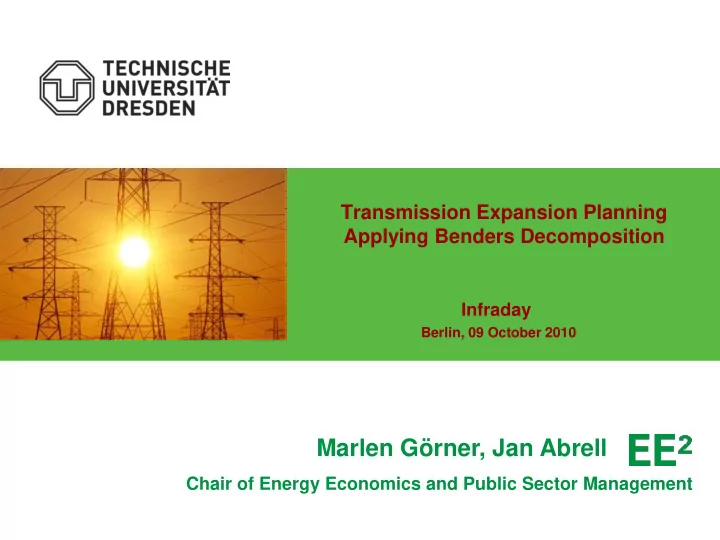

Transmission Expansion Planning Applying Benders Decomposition Infraday Berlin, 09 October 2010 Marlen Görner, Jan Abrell Chair of Energy Economics and Public Sector Management
Agenda 1. Motivation 2. Model Formulation 3. Decomposition a. Benders Decomposition b. GAMS Solvers 4. Results 5. Conclusion - 2 -
Motivation Wind Demand Solar Source: Leuthold et al. (2008) - 3 -
Benders Decomposition in TNEP Selected Works • Pereira et al. (1985): - First application to TNEP with linearized power flow model • Romero and Monticelli (1994): - Hierarchical Approach to obtain global optimality despite of nonconvexity • Oliveira et al. (1995): - Integer master problem solved only to feasibility, not optimality to make use of heuristics • Siddiqi and Baughman (1995): - AC load flow model • Binato et al. (2001): - Gomory Cuts and ‘Big M‘ scaling mechanism • Shrestha and Fonseka (2004): - Competitive market considering different convergence strategies - Dynamic model with LP master problem and quadratic subproblem - 4 -
Agenda 1. Motivation 2. Model Formulation 3. Decomposition a. Benders Decomposition b. GAMS Solvers 4. Results 5. Conclusion - 5 -
The Transmission Expansion Problem (TNEP) - 6 -
Agenda 1. Motivation 2. Model Formulation 3. Decomposition a. Benders Decomposition b. GAMS Solvers 4. Results 5. Conclusion - 7 -
Benders Decomposition of the TNEP S TART M ASTER P ROBLEM (Investment Decision) Grid Structure EF l Lower Bound Z LB S UBPROBLEM (Optimal Dispatch) N O Feasible Solution? A DD B ENDERS C UT I NFEASIBILITY S UBPROBLEM (Artificial Dispatch) Y ES Upper Bound Z UP Benders Cut N O C ONVERGENCE C HECK Z LB = Z UP ? Yes Optimal Solution - 8 - E ND
The Master Problem (MP) • Investment Problem (MILP) • Integer Expansion Factor (EF l ) as choice variable • Only constraints on EF l included → relaxed TNEP • Optimal value constitutes lower bound to TNEP problem - 9 -
The Subproblem (SP) • Optimal Dispatch Problem (NLP) • Contains technical and economic constraints • Integer variable EF l fixed to MP solution → Upper bound to TNEP • Output: λ l and all variables of TNEP - 10 -
The Infeasible Subproblem • Introduce Slack variables into Energy Balance • Obtain always-feasible solution • ‘Punish’ use of slack by adding a large value to objective function - 11 -
New Iteration Convergence Check: ? Optimal solution found New Master Problem with Benders Cut: - 12 -
GAMS Solvers DICOPT (DIscrete and Continuous Optimizer) • Outer Approximation (MIP and NLP problems) • Equality Relaxation • Augmented Penalties SBB (Standard Branch & Bound) • Branch & Bound algorithm (NLP subproblems) • Pseudo Cost possible DICOPT with advantages when many discrete variables, SBB when complexer nonlinearities are faced - 13 -
Agenda 1. Motivation 2. Model Formulation 3. Decomposition a. Benders Decomposition b. GAMS Solvers 4. Results 5. Conclusion - 14 -
Grid Structures • BeNeLux-L • BeNeLux-S - 94 nodes, 120 lines - 15 nodes, 28 (+5) lines - 15 -
Results - Comparison to GAMS Solvers • For small problems GAMS solvers outdo Benders Algorithm • Already medium-sized BeNeLux-L with large savings • For TNEP SBB slightly faster than DICOPT - 16 -
Grid Expansion Scenarios Base Case • Based on data sets from 2007, no additional features Security • Base Case plus reliability margin of 20% on thermal limits of all lines Wind 2020 • Additional 15 GW wind installed along coastal line of Belgium and The Netherlands - 17 -
Base Case • Prices in North higher than in South • Expansion of cross-border line capacities • Massive line expansion in Southern part to satisfy demand center in Southern NL • In today‘s grid line expansion brings overall cost savings - 18 -
Security Scenario • Only small differences to Base Case: - Overall higher price level - More lines expanded - Same corridors expanded as in Base Case - 19 -
Wind 2020 • Lower Price Levels • In North: Highly negative prices Interpretation - Large amounts of wind fed in as must-run condition - Economic gains from selling at negative prices to lower line congestion rents • Hardly any line expansion Interpretation - No need to import due to high amount of cheap electricity along the coast - 20 -
Agenda 1. Motivation 2. Model Formulation 3. Decomposition a. Benders Decomposition b. GAMS Solvers 4. Results 5. Conclusion - 21 -
Conclusion • Already in the existing grid network expansion pays off • Higher security in grid structure comes with higher expansion cost and price levels • Wind can (in BeNeLux) have positive impact on network • Benders Decomposition is applied successfully to TNEP • For large model sizes more time-efficient than intern GAMS solvers Future Work: • Enhance Algorithm via - ‘Big M’ scaling - Hierarchical Approach - Introduction of Gomory Cuts • Apply to larger datasets • Include HVDC expansion choice • Differentiate generation technologies and line investment cost - 22 -
Thank you very much for your attention! Any questions or comments? Marlen.Goerner@Mailbox.TU-Dresden.de Chair of Energy Economics and Public Sector Management
Recommend
More recommend